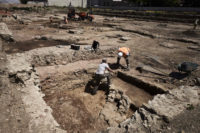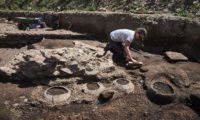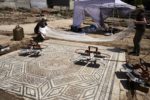 Archaeologists surveying a site before construction of a housing development on the outskirts of the city of Vienne, east-central France, have unearthed an entire Roman neighborhood. Located on the right bank of the River Rhône less than 20 miles south of Lyon in the small municipality of Sainte Colombes, the site covers an astonishing 7,000 square meters (75,347 square feet) and contains extensive remains of private and public structures from the 1st century A.D. through the 3rd century.
Archaeologists surveying a site before construction of a housing development on the outskirts of the city of Vienne, east-central France, have unearthed an entire Roman neighborhood. Located on the right bank of the River Rhône less than 20 miles south of Lyon in the small municipality of Sainte Colombes, the site covers an astonishing 7,000 square meters (75,347 square feet) and contains extensive remains of private and public structures from the 1st century A.D. through the 3rd century.
Some of the buildings discovered this far include luxurious private homes, shopfronts and a large public structure built on what had previously been a market whose standout feature is a monumental fountain with a statue of Hercules. Archaeologist and excavation leader Benjamin Clément thinks it may have been a school of rhetoric or philosophy. Vienne had a very famous one (it’s mentioned in several inscriptions) but its remains haven’t been found. This may be it.
 The ancient city of Vienne which was a major transportation hub in Roman Gaul. The Rhône and one of the most important Roman roads in the country, the Via Agrippa, both passed through Vienne. It was prosperous and it showed, with its circus and an early Imperia temple to Augustus and his wife Livia erected by the Emperor Claudius. In Roman times Vienne covered both sides of the river. Modern Vienne cleaves to the left bank while Sainte Colombes occupies the right. The Roman archaeological site of Saint-Romain-en-Gal and its Gallo-Roman museum are on the right bank.
The ancient city of Vienne which was a major transportation hub in Roman Gaul. The Rhône and one of the most important Roman roads in the country, the Via Agrippa, both passed through Vienne. It was prosperous and it showed, with its circus and an early Imperia temple to Augustus and his wife Livia erected by the Emperor Claudius. In Roman times Vienne covered both sides of the river. Modern Vienne cleaves to the left bank while Sainte Colombes occupies the right. The Roman archaeological site of Saint-Romain-en-Gal and its Gallo-Roman museum are on the right bank.
There is evidence that the neighborhood was devastated by two major fires, one in the early 2nd century and the other in the middle of the 3rd century. Inhabitants rebuilt after the first fire, but the second seems to have resulted in the permanent abandonment of the site. Because their departure was hasty and under pressure, residents left behind a number of artifacts. Add to that the good condition of several of the buildings and the inevitable Pompeii comparisons arise. Like most sites cursed with a Pompeii-related monicker, it bears only a the most passing resemblance to the ancient city that was both preserved and destroyed by a natural disaster.
Among the structures to have partly survived are an imposing home dubbed the Bacchanalian House after a tiled floor depicting a procession of maenads (female followers of the god of wine, known as Dionysus or Bacchus) and joyful half-man, half-goat creatures known as satyrs.
A blaze consumed the first floor, roof and balcony of the sumptuous home, which boasted balustrades, marble tiling, expansive gardens and a water supply system, but parts of the collapsed structure survived.
The archaeologists believe the house belonged to a wealthy merchant.
“We will be able to restore this house from the floor to the ceiling,” [dig leader Benjamin] Clement said.
In another house, an exquisite mosaic depicts a bare-bottomed Thalia, muse and patron of comedy, being kidnapped by a lustful Pan, god of the satyrs.
 Excavations were originally scheduled to end in September, but nobody expected to find such rich archaeological materials so the dig has been extended to December. That will barely scratch the surface of so large an ancient site. The real estate development will go forward as planned, so archaeologists are going to have to remove everything they can to preserve it in the laboratory. Some of the finds will go on temporary display in a 2019 exhibition at the Gallo-Roman Museum about the Via Agrippa and its significance to the region.
Excavations were originally scheduled to end in September, but nobody expected to find such rich archaeological materials so the dig has been extended to December. That will barely scratch the surface of so large an ancient site. The real estate development will go forward as planned, so archaeologists are going to have to remove everything they can to preserve it in the laboratory. Some of the finds will go on temporary display in a 2019 exhibition at the Gallo-Roman Museum about the Via Agrippa and its significance to the region.